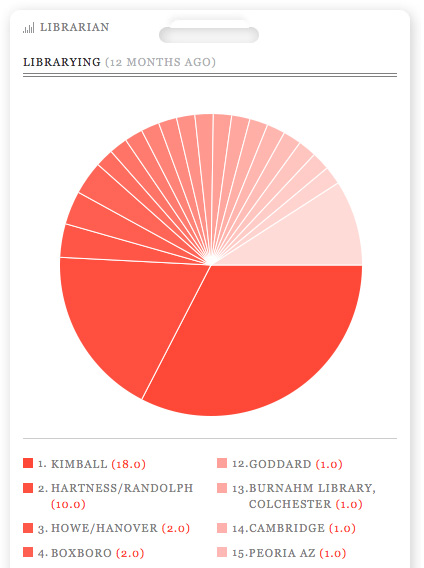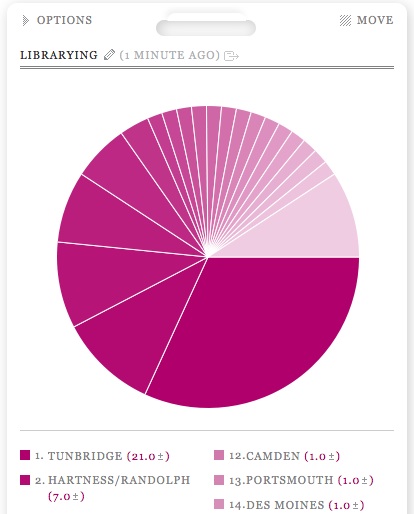Rochelle links to a survey done by the Wisconsin Public Library Consortium (pdf) which looks at how library users and non-users look at library services across the state of Wisconsin. It also compares results this year with results from the same survey four years ago, so looking at the trends is also revealing. The report is about twenty pages long and worth a pretty good scan. I have a few comments on the survey and the results.
First off, I am the typical “most likely to use the library” user according to this survey. Late 30s, female, comfy with computers and a regular internet user. And, guess what, I use the library all the time! Secondly, the survey puts people into user and non-user groups based on how they answer the question “Which of the following terms best describes how regularly you personally use your public library?†If you answer rarely or never, you’re a non-user. If you answer very or somewhat regularly, you’re a user. I assume there is a decent reason to do this, but I’d think even if you went to a library a few times a year, I’d consider that a rare user but also not a non-user.
One of the most interesting parts of the survey results is on page 16 entitled “New Initiatives” where they ask about how interested patrons are about using some new technology initiatives. To me they are asking all the wrong questions (mostly about content, less about context). They ask a lot of questions about downloadable content, which makes sense since the library probably has to shell out money for these things and wants to figure out if they’re worth it. However, they also ask about 24/7 librarian access and IMing a librarian and also find that people tend towards the “slightly disinterested” side. In fact the only new technology initiative that got anything that fell towards the positive side was wireless internet access. I wish they’d asked more questions about computers generally. Do people want more classes? Do they want more Macs? Do they want more public access PCs?
The next fascinating page follows: what would make you use the library more. The two runaway favorite answers are “If it were open more hours” and “If it had more CDs/DVDs/videos that I wanted” This will definitely be helpful for libraries who are facing funding drives since they can direct appeals appropriately, but I’m curious how the hours question breaks down. Do people want late night hours (as I do), or morning hours, or consistent hours, or weekend hours, what? Similarly, the difference between people wanting more classical music CDs (or any music CDs if your library doesn’t have a music collection) is worlds away from wanting popular movie DVDs.
Lastly, I’d like to point to the Internet question which was sort of glossed over. Of all the people surveyed 26% had no Internet at home and 23% only had dial-up. That’s nearly half the respondents having a level of connectivity at home where a downloadable audiobook is worth basically nothing to them, and likely a group that doesn’t spend a lot of time online. I’m not saying that we shouldn’t still stress technology initiatives, but that’s a pretty sobering takeaway when you’re trying to provide more and more services online.
The summary from the group that did the survey has an odd, to me, conclusion.
So, this information presents a juncture: On one hand, if you interpret the results literally you could make a decision to reject technology and focus on building a collection around personal enjoyment for Wisconsin residents. On the other hand, these same results may suggest that initiatives and library services need to be marketed in such a way that resonates with current conceptions of a public library. To this end, I would suggest an exploration of branding Wisconsin library services to more effectively market services. But, regardless of the direction taken from the juncture, a heightened focus on Wisconsin public library customers and customer service is essential in order to expand and maintain your current brand loyalty.
Do they realy think that the solution to getting more people to perceive value from the libraries technology initiatives is to just find a more effective way to market them? Aren’t there questions they could have asked about the services that would have helped nail this down more effectively such as “Are you aare that the library offers downloadable audio books?” “Do you use this service, why or why not?”
As I’ve said before, I think that before we can fully immerse ourselves in a 2.0 initiative as librarians, we have to make sure we’re counting the right things. If you only collect internal statistics on reference interactions that happen in-person or on the phone, it’s no wonder that IM reference seems like a “flavor of the month” thing for the library to do. And, after the fact, if you can’t show that people are really using the new techie things that you do provide it’s harder to stress that those things that should be part of what your library is and does. Many of these things are countable — website stats, flickr photostream views, IM interactions — the question is: are we counting them?

